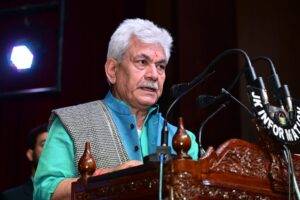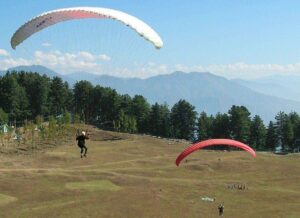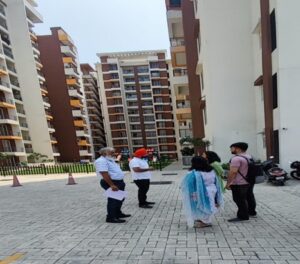Last Updated on May 5, 2022 at 4:28 pm
The Delimitation Commission headed by Justice Ranjana Prakash Desai, (a retired Judge of the Supreme Court of India), and Sushil Chandra, (Chief Election Commissioner) and K.K. Sharma, (State Election Commissioner, Union Territory of Jammu and Kashmir), as Ex-Officio members of the Delimitation Commission met today to finalise the Delimitation order for the Union Territory of Jammu & Kashmir. The Gazette notification for the same has also been published today.
Out of the 90 Assembly Constituencies in the region, 43 will be part of Jammu region and 47 for Kashmir region keeping in view the provisions of Section 9(1)(a) of the Delimitation Act, 2oo2 and Section 6o(2)(b) of Jammu & Kashmir Reorganrzation Act, 2O19.
After consultation with Associate Members, representatives of political parties, citizens, civil society groups, gACs have been reserved for STs, out of which, 6 are in Jammu region and 3 ACs in the Valley.
There are five Parliamentary Constituencies in the region. The Delimitation Commission has seen the Jammu & Kashmir region as one single Union Territory. Therefore, one of theParliamentary Constituency has been carved out combining Anantnag region in the Valley and Rajouri & Poonch of Jammu region.
By this reorganisation each Parliamentary Constituency will have equal number of 18 Assembly Constituencies each. Names of some ACs have also been changed keeping in view the demand of local representatives. It may be recalled that the Delimitation Commission was constituted by the Govt. of India, in exercise of powers conferred by Section 3 of Delimitation Act, 2002 (33 of 20ozl, for the purpose of delimitation of Assembly and Parliamentary Constituencies in the Union Territory of Jammu & Kashmir. The Commission associated in its work, 5 members of Lok Sabha elected from the UT of Jammu and Kashmir. These Associate Members were nominated by the speaker of Lok Sabha.
The Delimitation Commission was entrusted with the work of delimiting the Assembly and Parliamentary Constituencies in the UT of Jammu and Kashmir on the basis of 2O11 Census and in accordance with the provisions of Part-V of the Jammu and Kashmir Reorganisation Act, 2019 (34 of 2Ol9) and the provisions of Delimitation Act, 2OO2(33 of 2OO2).
Having regard to relevant provisions of the Constitution (Article 330 and Article 332) and sub-sections (6) and l7l of Section 14 of the Jammu and Kashmir Reorganisation Act 2019, the number of seats to be reserved for the Scheduled Castes (SCs) and Scheduled Tribes (STs) in the Legislative Assembly of the Union Territory of Jammu and Kashmir was worked out on the basis of 2OL1 Census. Accordingly, the Delimitation Commission has reser’,red 9 ACs for STs for the first time and 07 for SCs. It is worthwhile to mention that the Constitution of erstwhile Jammu and Kashmir State did not provide for reservation of seats for the Scheduled Tribes in the Legislative Assembly.
The Jammu and Kashmir Reorganisation Act, 2019 and Delimitation Act, 2002 laid down the broad parameters within which the delimitation exercise was to be carried out. However, the Commission formulated Guidelines and Methodologr for delimitation of Assembly and Parliamentary Constituencies in Jammu and Kashmir, for smooth functioning and effective results, and the same were followed during the delimitation process.
Keeping in view the geographical features, means of communication, public convenience, contiguity of areas as various factors enumerated in Section 9(1) of the Delimitation Act, 2oo2 and the inputs gathered during the Commission’s visit to the UT from 6th to 9ft July 2o2L, the Commission categorised all 20 districts into three broad categories i.e. A- Districts having predominantly hilly and difficult areas, B- Districts with Hill & Flat areas and C- Districts with predominantly Flat areas.
The Commission has also, for some districts, proposed carving out of an additional constituency to
balance the representation for geographical areas having inadequate communication and lack of public conveniences due to their excessive remoteness or inhospitable conditions on the international border.
The Commission had decided that Constituencies shall be delimited having regard to the administrative units i.e. Districts, Tehsils, Patwar circles.
It was ensured by the Commission that every Assembly Constituency shall be contained entirely in
one district and the lowest administrative units i.e. Patwar Circles (and Wards in Jammu Municipal Corporation) were not broken and were kept in single Assembly Constituency.
The Commission conducted a final round of internal meetings to examine all the suggestions and took decision on the changes to be made in the draft proposals. Most of the representations regarding the change of names of the proposed constituencies were accepted by the Commission in view of the public sentiment involved in the s€une. These name changes included naming Tangmarg-AC as Gulmarg-AC, zoonimar-AC as Zaidibal- AC, sonwar-AC as Lal chowk-AC, Padder-AC as Padder-Nagseni-AC, Kathua North-AC as Jasrota-AC, Kathua south-AC as Kathua-AC, Khour-AC as chhamb-AC, Mahore-AC as Gulabhgarh-AC, Darhal-AC as Budhal-AC, etc.
Provision of at least two members (one of them must be a female) from the communit5r of Kashmiri Migrants in the Legislative Assembly and such members may be given power at par with the power of nominated members, of the Legislative Assembly of Union Territory of Puducherry.
The central Government may consider giving the Displaced Persons from Pakistan occupied Jammu and Kashmir some representation in the Jammu and Kashmir Legislative Assembly, by way of nomination of representatives of the Displaced Persons from Pakistan Occupied Jammu and Kashmir.



